<< New Q&A
More Q&A, Part 11 >> Part 10
>> Part 9 >> Part 8 >> Part 7 >>
Part 6 >> Part 5 >>
Part 4 >> Part 3 >>
Part 2 >> Part 1
>> Gunwriters guns.connect.fi Link page

Custom Search
Latest update 05.05.2001
G.O.W. Kickback:
Questions and Answers, Part 12
Answered by: P. T. Kekkonen
Interesting Belgian revolver
 My name is Felipe, I'm from Brazil and like guns.
I'm not a collector, I just have some pieces. Maybe you can help me to identify this
revolver (atach a picture ). I know it is Belgian because have a stamp in the cylinder:
Oval with "ELG" letters and in the barrel: "R" with a crown. The
caliber is .36. I believe it is a Lebel or Warnant. I really appreciate if you can help
me...
My name is Felipe, I'm from Brazil and like guns.
I'm not a collector, I just have some pieces. Maybe you can help me to identify this
revolver (atach a picture ). I know it is Belgian because have a stamp in the cylinder:
Oval with "ELG" letters and in the barrel: "R" with a crown. The
caliber is .36. I believe it is a Lebel or Warnant. I really appreciate if you can help
me...
Sincerely, Felipe, Brazil
Your revolver is usually incorrectly known as "Gasser
Pattern revolver made for Kingdom of Montenegro". Its seems, however, built for
export to Imperial Russia, but these guns were sold also to South-America. Caliber may be
9 x 26R Gasser-Kropatschek, with actual bullet diameter .365. The hinged-frame action was
design of Belgian firearms manufacturer Jean Warnant and his assistant Fransquet,
but the twin-latch opening was designed by Philippe Counot of Belgian Auguste Francotte's
plant. Design of Warnant & Fransquet had just one opening lever on the right or left
side of frame.
There were four models of Montenegrian Gasser revolvers produced by Leopold Gasser and
many Belgian firms for export to the Montenegrian Kingdom until 1918. It was a common
practise that small Belgian manufacturers did not inscribe or stamp their name on the
revolvers and shotguns. 11 mm Montenegrian Gasser revolvers were heavy and big, usually
with twin-latch hinged frame. (Opening levers on both sides of the frame; Counot's
design). Cases for them can be made from .45 - 70 Government rifle cases. There were,
however, also revolvers chambered for 9 x 26 mm G-K cartridges; so-called "boy's
revolvers", usually made in Belgium. Montenegrian King Nikita (or Nicolas; reign 1910
- 18) was a notable shareholder of a firm Leopold Gasser and an efficient salesman of
old-fashioned revolvers, already before his royal reign.
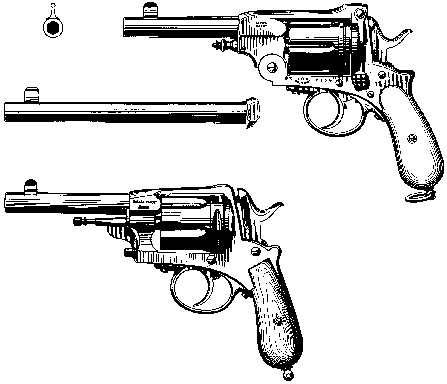
Above: Original Gasser Montenegrian revolver Model 1880 with hinged frame and Gounot's
twin-latch. Caliber 11 mm. Optional barrel lengths were either 133 mm or 235 mm.
Co-designer or this model, Archeduke Nikita (later King) of Montenegro, preferred
"Buntline Special" barrel with a length 235 mm.
Below: Solid-frame Gasser Model 1873 with five-shot cylinder. Caliber 11 mm. Also sold as
a "Montenegrian model".
King Nikita declared a famous Royal Act: "Every male citizen of Montenegro is a
member of the Militia, and therefore not only justified but also obliged to possess at
least one Gasser Pattern revolver." Montenegrian models were designed in 1880, both
solid-frame and hinged-frame versions, caliber usually 11 mm, but after declaration of
Royal Act the 9 mm G-K models became also popular, since the teen-ager or still younger
boys got the right (and obligation) to acquire, possess and carry a revolver. Population
of Montenegro was considerably less than half million citizens in 1910, but some patriotic
(= wealthy) Montenegrians acquired as many as a dozen Gasser wheelguns.
Huge orders of obsolete Montenegrian revolvers kept the firm Leopold Gasser alive until
the end of First World War, although Austro-Hungarian armed forces did no more order 8 mm
Rast-Gasser revolvers after adoptment of self-loading 9 mm Steyr-Hahn pistols since 1912.
Less wealthy citizens of Montenegrian Kingdom acquired cheap Belgian look-alikes of
Montenegrian Gasser revolvers, including Warnant's Montenegrian models, because the Royal
Act mentioned Gasser as a pattern of revolver but not as an actual manufacturer of it.
Name "Gasser Pattern" was incorrect, because hinged-frame model was a Belgian
design, sometimes with a patent marking: "Warnant-Fransquet Brevete" on
the left side of barrel and sometimes with a trade-mark: "L & J Warnant.
Hognee, Belgique". No other stamps but proof-marks "LEG" in oval and
"R" with a crown were mandatory on the Belgian firearms. ("R" = "Rayé"
is a Belgian proof-mark on rifled firearms and revolvers. "Brevete" or
"Bte" means "a patent"). Manufacturers of high-quality
Belgian firearms like Warnant, Aug. Francotte, F.N. and some others stamped trade-marks or
patent markings on their products, but there were also many anonyme producers of Belgian
handguns and shotguns.
(Anonyme Spanish firearms were and are also common all'round the world, being the scourges
for the gunwriters: Owners of them are eager to know the year when their
"heirlooms" are made and whether they are safe to shoot, or whether they are
"valuable collector's items").
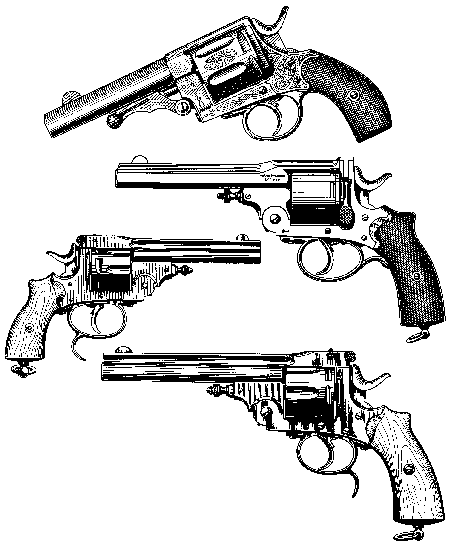
From top to down:
L & J Warnant's "Montenegrian Model" with solid frame. Caliber 11
mm. Five-shot cylinder.
Original hinged-frame Warnant revolver with marking: "Warnant-
Fransquet Bte". Bolt lever on the left side of frame only.
Warnant's "Russian export" revolvers with finger hook
triggerguard and hinged frame with Smith & Wesson's latch design. Note also a barrel
rib similar to Smith & Wesson Russian model. Pocket-sized revolvers were chambered for
.380 Enfield (9 x 20 R) caliber commercial cartridges, also known as .38 Smith &
Wesson (Short; not Special), loaded by Cartoucherie Russo-Belge in Liège, Belgium since
1890 until the First World War.
Bigger Military & Constabulary Model was chambered for 9 mm (.38 S & W/ .380
Enfield) or .44 S & W Russian cartridges.
Hook-like triggerguard projection for middle finger denotes export effort to Imperial
Russia, where this kind of triggerguard spur was familiar from Smith & Wesson Russian
revolvers. Warnant's exclusive Montenegrian model had a solid frame, and no finger hook.
Warnant's Russian models had this hook. Latch of hinged frame was similar to contemporary
Smith & Wesson revolvers and a sight rib on the barrel similar to S & W Russian
revolver, with a trade-mark inscribed or stamped on the rib.
Your revolver stays, unfortunately, still unknown to me, being an "anonyme Belgian
revolver; caliber .36 (presumably 9 x 26 mm G-K); Russian export model".
Sources of illustration. Photograph: Felipe (Brazil). Drawings: Alexandr
Borisovich Zhuk (Russia).
2104 MMI; PT
Mysterious "TIKKA" stamp on MP35
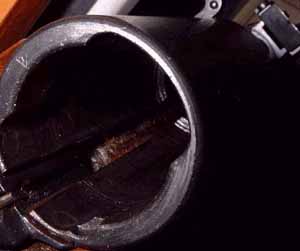
I have an MP35/I submachine gun that has absolutely no manufacturer markings, other than
the triangle with T symbol stamped into the end of the receiver tube. See picture
attached.
The gun is pre-WWII, has serial numbers and crown-over-N smokeless powder proof marks, no
other markings. Doesn't say "Bergmann", doesn't say "MP35/I"; nothing.
This is mysterious to me, and I wonder if anyone can shed any light on the likely history
of this gun.
Thank you. Byron, New Mexico, USA
"T
in a triangle" is really a stamp of Tikkakoski Oy.
All other remains a guesswork, but likely history is that this very gun is truly made by
Tikkakoski Oy, as a sample for planned production of MP 35 (or actually "Bergmann
Maschinen Karabiner": BMK) in Finland. Production of submachine guns was banned
in Germany since 1918 until ca. 1935. Just those "Machine Carbines" were allowed
to product for police forces, according to the dictates of Versailles "Peace
Treaty".
BMK was designed in 1932. A limited batch of these guns was made in Germany "for
official use", i.e. for police (but not for German Army). German military firearms
designs were scattered to foreign countries after WW I: Production of Bergmann MP 18/I
submachine guns and machine cannons into Switzerland; production of MP
28/II mainly into Belgium; yield of Rheinmetall MP (designed in Switzerland) into
Austria, et cetera... Rheinmetall submachine gun is known as a Steyr-Solothurn MP 34, but
the very first Rheinmetall's experimential model was MKb 19.
(Swiss-made submachine guns were also "machine carbines". Some of them were
really cavalry-carbine sized guns with ca. 20 inch barrel length and delayed blowback
"momentum block" action with system Pedersen. Examples: SIG/ Neuhausen MKMO and
self-loading MKPO police carbine. SIG made also licenced copies of Bergmann MP 18/I
submachine guns acquired for Finnish Civil Guard in 1920s).
Swiss "Solothurn" plant was actually a branch of "Rheinischen
Metallwaaren- und Maschinenfabrik". Since 1922 until 1933 many German weapon
designers kept their skill up-to-dated also in Soviet-Russia by the Rapallo Treaty in
1922: Germans developed tanks, military aeroplanes, submarines and technology of
ammunition production, sharing their know-how with Soviet-Russians. Post-WW I Germany and
Soviet-Russia were "castaway nations" and German Weimar Republic had a
social-democratic administration, politically not so very far from the Russian bolshevism.
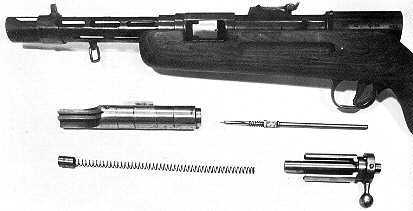
Mechanisms of BMK and MP 35 were similar. Cocking handle was
non-reciprocating. Cocking movements of the breech-bolt were similar to loading of a
Mauser rifle: Handle up-backwards-forwards-down. MP 35 was estimated to be "overly
complicated and expensive to mass-produce" when compared with MP 38 and especially
with MP 40. Limited production of MP 35 was, however, continued until the tail-end of
Second World War in Germany.
When BMK was designed, it was necessary to find a mass-producer for this new gun outside
Germany, or to get opinion about BMK's suitability for large-scale production by
experience. Germans knew very well quality of Tikkakoski Oy products, including (and
especially) SUOMI KP -31. In 1932 here was an era of Great
Depression: Tikkakoski Oy had excessive production capacity, when compared with
contemporary demand of submachine guns in Finland. (There were just ca. 4000 Suomi KP -31s
in use during our Winter War 1939 - 40. Need was ca. 50 000 submachine guns, but according
to some Finnish politicians "war is an impossible incident in our time, being too
expensive way to settle controversies!". Neville Chamberlain was not only European
goofy during the late 1930s). Also, don't forget that main stockholder of Tikkakoski Oy
was a citizen of Germany, Willi Daugs, who had connections with German
industrialists and firearms designers.
It is impossible to confirm that your BMK is "a sample of the Finnish
craftmanship" made by Tikkakoski Oy for Germans, but there is some circumstantial
evidence to speak for this surmise. Especially lack of any other markings but mandatory
German proof-mark and serial numbers (also mandatory for records of proof-house) plus the
stamp of Tikkakoski Oy. If there are not any signs of ground-away markings on the receiver
of your BMK, it may be made in Finland as an unique sample gun. It is easy to fake "T
in triangle" stamp, but difficult to remove original markings without tell-tale signs
of grinding and welding.
Please Note: There was never a submachine gun OFFICIALLY known as MP 35/I but BMK, and MP
35 since 1936, when the name "Maschinen Pistole" was again politically correct
in Germany, after nullify of Versailles Dictates. Between the models BMK and MP 35 were
some external differences but actions of them were similar. In official military
nomenclature is also known an abbreviation MP 35 Bgm. During the WW II a small batch of MP
35 guns were made also by a firm Junker & Ruh (code: "ajf") still
in 1944. Non-German (and some German?) literature knows BMK either as MP 34 or as MP 35/I,
but those abbreviations are unofficial and historically incorrect.
2104 MMI; PT
Finnish army belt pistol
What are your official sidearms in the army?
Péter; Hungary
Belgian
9 x 19 mm F.N. pistols with double-action trigger mechanism. Otherwise like model F.N.
GP-35.
2204 MMI; PT
Restoring the T34
I read your story about restoring the T34 with great interest.
We are doing the same. We have a T34 that finally stopped running and we are trying to get
it going again. Are you the person to contact with questions that we will have as we
continue to restore our machine?
Hans from West Coast Armor and Artillery Museum Petaluma, California, USA
Sorry, I
am not the person you're seeking, because you have troubles with engine and not the cannon
or machine guns of your T34. I've never been a member of "tank crew" in our Arms
Historic Guild of North-Carelia. The story about restoring the T34/86 was written by
our "tele-operator" J. Hartikka. As far as I know, the engine of T34 was
designed for Russian tugboats. I hope that those engines are still available from Russia.
If the power transmission is a source of troubles, I am simply unable to help you, being
ignorant about technology of tracked vehicles (or vehicles at all: I have never had
driver's licence even for running a motor car, motor bicycle or a tractor).
2304 MMI; PT
New Finnish suppressor
Hi Pete! Excellent to see that GOW is still alive, you mentioned a while back a new
suppressor for hi-power rifles, made by AU. Do you have any details on it, and maybe a
website? At the moment I am using a Reflex T8M
suppressor on my TRG-41, in .338 LM, and loving it.
Yours Chris, New Zealand.
There is
an article written by MPP about AU "Jet-Z"
(pronounced "yet chet" in Finland) suppressor published on GOW/Finnish site.
Click on the word Suomeksi and then Ruutisten when the title page of GOW/Finnish exists on
screen. The same article is also published on ASE UTRA website; click on Jet-Z esittely.

Construction of Jet-Z on a photo. Somewhat complicated; impossible
to mass-produce. Baffles are machined from a steel bar-stock. Therefore they are very
durable. Diameter of Magnum Jet-Z is 45 millimeters, length 250 mm and weight 690 grams.
Performance is excellent. Tested suppressor was smaller Jet-Z Standard variation for
rifles shooting medium-sized cartridges like .308 Winchester. Diameter of it is 40 mm,
length just 185 mm and weight 450 grams. Price is about twinfold when compared with
mass-produced Reflex T8M, but Jet-Z is designed to be everlasting, even when full-power
loads or factory-loaded cartridges shall become shot only.
Article is not yet translated to English. I'll try to translate it, especially if our
"freemason pigs" shall manage to suppress GOW/Finnish site. Then I'll get more
time to write and translate articles for GOW/Universal site.
0904 MMI; PT
Yellow tip denotes DANGER!
Hello kind and knowledgeable gentlemen. Can you, please, help me to identify different
colored bullet tips? I recently bought some .30 caliber bullets that had yellow painted
tips. I know that red means tracer and black means armor piercing. But what is yellow?
Many thanks, Al
Color
codes are different in various countries or military allies (NATO or ex-Warsaw
Pact). Examples given: In Soviet Union and most Warsaw Pact countries denotes black
.30 caliber/ 7.62 mm Mosin-Nagant bullet's tip an armor piercing bullet, but red-painted
tip was a code of explosive-incendiary bullet (ZP or ZR, a.k.a.
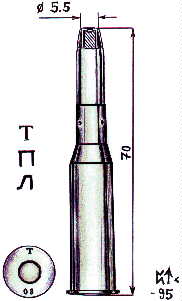 "ZaRa" bullet) after 1933 and
tracer-incendiary bullet since ca. 1916 until 1932. (This 7.62 mm Z-bullet was only
color-coded rifle projectile in Imperial Russia).
"ZaRa" bullet) after 1933 and
tracer-incendiary bullet since ca. 1916 until 1932. (This 7.62 mm Z-bullet was only
color-coded rifle projectile in Imperial Russia).
It's jacket was also plated with copper or Gilding metal, while usual
contemporary plating was cupro-nickel (= maillechort, or "melkhyor"
in Russian). Other bullets were identified by bullet point shape. Armor piercing bullet
had a separate copper point cap and cupro-nickel jacket until 1930. High-explosive bullet
had concave bottom of copper explosive-filled capsule projecting from it's point. Old ball
model 1891 had round point and most usual ball model 1908/10 had sharp point.
Tracer-incendiary bullet was also pointed. A color code and Gilding metal plating was
therefore needed for Z-bullet.
In Finland was color code of AP bullet a blue tip. Finnish 7.62 (or
actually .303 caliber) bullets with yellow point were hazardous to use. They were filled
with white phosphorus, having incendiary effect on the hard (but non-armored) targets.
Cartridges with incendiary bullets having also some explosion effect were issued to
Finnish Air Forces. They were variants of British BUCKINGHAM "Anti-Zeppelin"
incendiary projectiles, but without side-bleed aperture and smoke tracer, since they were
intented for shooting against aeroplanes; no more against dirigibles or balloons. First
lots of yellow-pointed bullets were bought from England until the Finns learned to
assembly them in Finland, fortunately enough: England declared a war against Finland in
6th December 1941. Peace was concluded in 1947.
Soviet-Russian 7.62 mm bullet's yellow point denotes lead-filled
boattailed D-30 bullet for long-range machine gun shooting. Contrary to Finnish
yellow-nosed projectile, it has neither explosive nor incendiary effect. It is an usual
"ball". Other countries or allies using yellow color code on bullet point are as
follows, namely:
Argentina: Old bullet tip-code denotes "Smoke Tracer". (May be
phosphorus-filled "side-bleed" Buckingham incendiary bullet? Surplus bought from
England? .303 British bullets are fit for Argentinian 7.65 mm Mauser cartridges).
New code denotes Observation, EXPLOSIVE! Cartridges are dangerous to disassemble with an
inertia bullet puller!
France: Post-WW II, Observation, EXPLOSIVE! See caution above.
NATO: Observation, EXPLOSIVE! See caution above.
England & British Commonwealth countries before year 1955: Proof Load
for .303 British firearms. Ball is as usual, but cartridges may be dangerous to shoot
because of high chamber pressure.
I presume that your .30 caliber bullets are made in/for some NATO member and so they are
explosive projectiles. Handle them with care! With a couple of exceptions: YELLOW
BULLET POINT OR TIP DENOTES A DANGER!
0904 MMI; PT
APPENDIX I Color codes of standard NATO small arms bullets:
Red tip: Tracer with Immediate Ignition
Black tip: Armor Piercing
Silvery tip: Armor Piercing Incendiary
Blue tip: Incendiary
Yellow tip: Observation (Explosive!)
Yellow tip & red point: Observation with Tracer (Explosive!)
Orange tip: Tracer with Dim Ignition
APPENDIX II Imperial Russian 7.62 mm Mosin-Nagant bullets:
Round point: Ball model 1891
Sharp point: Ball model 1908, without crimp groove
Sharp point; Ball model 1908/-10, with a crimp groove
Round point, lead: Short-range practice lead bullet model 1913.
("Inside lubricated": A deep hollow base was filled with lubricant and four
square apertures went through the bullet "skirt"). Overall length of cartridge
was ca. 60 mm
Round point, lead: Earlier short-range practice or "gallery
load" cartridge with spherical bullet. Hemispherical point. Cartridge overall length
was ca. 57 mm
Flat point (flush): High-Explosive model 1908
Flat point (concave): High-Explosive model 1915/-16. Bottom of copper
explosive capsule extends 1.5 mm from bullet point. Bullet was a ball model 1891 with a
point drilled to receive a copper capsule
Sharp copper point-cap: Armor Piercing bullet model 1915/-16
Red tip, sharp point: Incendiary Tracer bullet model 1915/-16 (Also
known as "ranging bullet" in some literature). Broad bright tracer flame with 3
seconds duration. Immediate ignition in the bore. Brass case headstamped before 1933.
APPENDIX III Soviet tip color codes of 7.62 mm M-N bullets, from 1930. Standard
issue bullets with sharp point:
None: Light ball "L" model 1908/-10
Yellow: Boat-tail machine gun ball D-30
Silvery: Light boat-tail ball "LPS". Iron core
Silvery: "LPS" since 1983. Hardened steel core
Green tip: Tracer T-30. Green tracer flame
Black tip: Armor Piercing B-30
Black/red tip: Armor Piercing Incendiary (old code)
Black/yellow tip: Armor Piercing Incendiary (new code)
Purple/red/green tip: Armor Piercing Incendiary Tracer
Red tip: Incendiary Explosive Observing ZR-33
Rarities. Usually unknown on literature:
Green bullet: Subsonic load before 1941. Sometimes bullet and entire
case (loaded cartridge!) was dipped into green lacquer, sometimes just the visible part of
bullet and neck & shoulders of a case were lacquered green, along with the head of
cartridge.
Green tip acme: Subsonic load since 1941. Just the bullet's sharp apex
and primer seal were lacquered green.
Black bullet: Reduced-charge load. Supersonic, although used with a
suppressor S-40. Cartridge case was also chemically blackened entirely. (Bullets with
cupro-nickel plating on steel jacket were not blackened. Just those bullets with Gilding
metal or copper plating received bluish-black color).
Lead tip: Subsonic load for hunting of small-game. Very short and light
soft-pointed bullet with a jacket looking like brass. Point shape hemispherical with
diameter 8.0 millimeters. (Post-WW II "civilian" design for selected
professional hunters, who were privileged to possess rifled breech-loading firearms.
Replaced by .22 LR rifles and cartridges in 1950s and 60s). Cartridge overall length was
ca. 60 mm.
1004 MMI; PT
Progenitors of a cartridge family
Dear Pete: Do you know anything about 6,5 x 54 mm Mannlicher- Schönauer
cartridge? About its history, effects, and reloading datas...
Thanks; MEHMET S:m, TURKIYE
6.5 mm
M-S cartridge was designed a full century ago for a rifle adopted in Creek as a Mannlicher
Model 1903 military rifle. Italians were adopded about similar 6.5 x 52 mm Mannlicher-Carcano
cartridge ten years earlier (in 1891) and during the last decade of 19th century many
countries like Netherlands, Roumania, Sweden, Japan and Portugal adopted 6.5 mm rifles for
their armed forces. The very first assault rifle in the world, FYODOROVA AVTOMAT Model
1916, was chambered to shoot 6.5 mm Arisaka (Japanese) cartridges with
somewhat reduced powder charges. It's designer VLADIMIR G. FYODOROV was a protagonist of
caliber 6.5 mm and shortened case (about 40 mm) until the final adoptment of 7.62 x 39 mm
cartridge in 1943.
Just the Crecian army adopted 6.5 mm M-S rifles, but the cartridge became soon popular
among hunters. Some most intrepid professional ivory hunters shot elephants with
full-metal jacketed bullets of 6.5 x 54 mm Mannlicher cartridges, since the low noise
level of a rifle didn't scare the elephant herd to escape or attack, and accuracy of rifle
allowed clean kills with well-placed brain shots. A long round-pointed FMJ bullet
perforated easily one meter thick cellular bone in the skull of elephant, without bending
and deviation. In the Northern Hemisphere an arctic explorer VILHJAMUR JOHANSSON slayed
several big polar bears with his beloved & infallible M-S hunting rifle. Actually, any
kind of medium and big game animals on the globe are slain with 6.5 x 54 mm rifles and
cartridges. All the major American ammo producers loaded 6.5 mm M-S cartridges until the
Second World War era, with variety of bullets.
Effects as a military rifle are typical to 6.5 mm roundnose FMJ bullets with a low
velocity: Narrow and straight wound channel, easy to heal, unless the bullet perforated
vital organs. Hit on the central nervous system or cardio-vascular area in chest was
usually fatal. Explosion-like effects were noted just if the bullet (shot from a very
short distance) hit the filled stomach, full urinary bladder or liver (and the skull, of
course). Muzzle velocity of standard military FMJ-RN bullet was mere 680 meters per
second. So the effect was depending on the placement of hit only. Penetration of bullet
was deep and straight, without notable "yaw effect". A good bullet for elephant
hunting is a poor projectile for warfare, unless it's caliber is at least 9 millimeters.
This is an acceptable rule! For hunting there were and are still available a choice of
soft-pointed bullets with more devastating hit effects.
There is reloading data available for 6.5 mm M-S with American powders only. I don't know,
whether those powders like DuPONT/ IMR 3031, 4895, 4350 or 4064 are available in Turkiye.
Please, tell to us the names of internationally known powders available there. We are able
to look from a QUICKLOAD Ballistic Program the safe loads for bullets with the weight up
to 10.3 grams; the elephant slayer. Reloader of M-S cartridge must be careful: Maximum
allowed chamber pressure (measured with copper crusher gauge) is mere 2700 atmospheres. On
the other hand: Noise of report is rather low and the recoil is pleasingly soft.
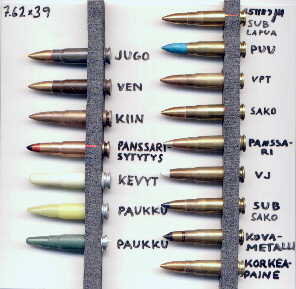
Archive photo: Russian M43
Kalashnikov cartridges are actually close relatives to Mannlicher Carcano 1891
through experimental Geco M35.
Cartridges based on approximate head dimensions similar to the 6.5 x 54 mm are as
follows, namely:
6.5 x 52 mm Mannlicher-Carcano (Italy, 1891; a predecessor).
7.75 x 39 mm Geco M35 (shortened and necked-up; Germany, 1934).
7.62 x 39 mm (Yelisarov & Syemin; Soviet-Russia, 1943,
almost identical copy of Geco cartridge).
.220 Russian (necked-down M-43; Soviet-Russia, about 1960).
.22 PPC (variation of .220 Russian with a pocket for small primers, Pindell &
Palmisano; USA, 1974).
.22 PPC - USA (SAKO Oy; Finland, 1988. PLEASE NOTE: This cartridege may be dangerous to
shoot from rifles chambered for original .22 PPC cartridge! Additional name
"USA" is misleading!).
6 mm PPC (necked-up .22 PPC, Pindell & Palmisano; USA, 1975).
6 mm PPC - USA (SAKO Oy; Finland, 1988. PLEASE NOTE: This cartridge may be dangerous to
shoot from rifles chambered for original 6 mm PPC cartridge! Name "USA" is again
misleading!).
Case head diameter of this "Funny Family" of cartridges is 11.3 to 11.42
millimeters. Most widely distributed member of that "family" was and is 7.62 x
39 mm Yelisarov & Syemin ("Kalashnikov") cartridge; still
an officially adopted military cartridge in China, Cuba, Finland and many other emergent
countries. Head diameter of 6.5 x 54 mm M-S is somewhat more large; max. 11.52 mm. "Mannlicher
family" is, however, independent from "Mauser family" with head
diameter ca. 12 millimeters.
0204 MMI; PT
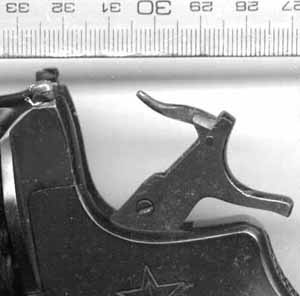
NAGANT REVOLVER CALIBER .22 LR
Hi, Comerades! Please help me! I have Nagant Revolver made in Tula 1936, Cal. 22
LR. This gun does not have a Firing Pin. Gunsmith can not make Firing Pin without Drawing
or Pic. with dimensions. He does not know, how this Pin looks like.
I know, in Finland people must have such Nagant. You got them in 1940. Please, if You have
it,- send me Pic. with dimensions or drawing!
Thank You, very much: Yefim. Dallas, Texas, USA.
My partner has
a .22 LR Nagant revolver, but I don't know, whether he has enough time to measure
dimensions of it's firing pin and create needed drawings with AUTO CAD. I have not
equipment for complicated measurements and I am able to write the text only. He may,
however, photograph or scan a pic. from the hammer of his .22 LR Nagant and give some
essential dimensions of the firing pin.
There is also published just recently an E-book "THE NAGANT REVOLVERS" on site: http://users.skynet.be/HL-Editions/index.html
.
I don't know, whether target revolvers or "DOSAAF-NAGANTs" with caliber .22 LR
are introduced by that E-book. "RADOM-NAGANT" (a rarity, made in Poland) is
seemingly unknown. Unfortunately, I have not direct contact with the Web, but just a
contents table of this E-book in my "writing computer". Our Russian contributor
Sergey is presumably willing to tell something about history of .22 LR caliber Nagant
revolvers.
2403 MMI; PT
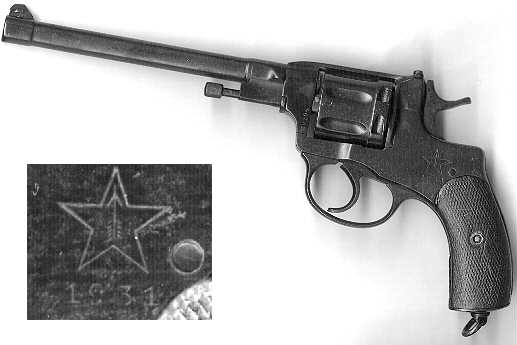
GOW archive photo: A .22 lr Nagant found from the Finnish -
Soviet front during the war 1940 - 1945 is presumably target practising revolver made for DOSAAF
or Pioneer organizations. Chambers are sleeved and barrel and sights are rebuilt.
It was probably lost by some Russian soldier killed in action. A Finn found it and
took it at home as a special souvenir. It is logical to assume that it was brought to the
front during the desperate days Russians had to assign any available firearms and troops
from Leningrad district to compensate heavy losses in the Finnish front.
Wanted!
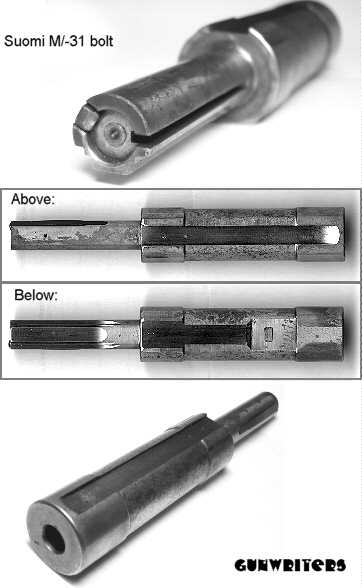
Pictures of KP/-31 bolt
I own a Suomi M31 sn/798, but my bolt seems to be damaged. Do
you by any chance happened to have a picture of the bolt (from different angles), so I can
repair the bolt.
Tnx A.H.
We have not
dimensioned drawings of SUOMI M31 bolt in our archives. What kind of damage is? A
deactivation or some minor fault? (Missing extractor? Broken firing pin point?) It is
frustrating, tricky and risky job to repair a deactivated bolt by welding additional metal
to the bolt, since welding shall deteriorate the original hardening and tempering of
nickel-alloyed steel bolt, making it too soft or too brittle. Try to find a spare part. We
can send to you just some photographs of intact bolt, but this is all we are able to do.
We have almost nil contacts with arms/ ammo & spare parts business in Finland and
abroad.
2603 MMI; PT
9 x 19 mm subsonic handloads
Thank you very much for the answer. I will try the load out first and then later I might
dare to try the removal of the locking rollers. (See Q & A
Kickback Part 12, updated 2403 MMI. Editor's note).
Also could you recommend a good subsonic load for a 9 mm Glock G17? I am using an Impuls
IIA silencer from Brügger and Thomet AG in Switzerland. Thank you in advance!
Sincerely; Lars (Norway).
Recommended powders for 9 x 19 mm Glock are those used also for ss-loads of your
G3. Recommended bullet weight is 8 grams/ 123 grains. For the first shooting trials you
may use an empty .22 Long Rifle case as a powder measure, filled up to its mouth level.
Add the powder carefully until you'll get reliable autoloading.
You should measure and tell volume of your cartridge cases (gram/grains weight of pure
water) by filling the case flush to it's mouth and weighing it. Also give weight of the
bullet you'll use for your ss-handloads. These are essential "inputs" to the
QUICKLOAD Ballistic program for exact "output" of loading data. Volume of 9 x 19
mm cases is variable in shells made by separate manufacturers, from ca. 0.85 gram to
almost one gram of water. (1 gram = 1 cubic centimeter of water). Knowledge on bullet
manufacturer and product number of a projectile is also needed for precise
"input".
There is already a lot of handloading data for 9 x 19 mm ss-cartridges published on GOW
sites, but it is somewhat hard to find and most information is written in Finnish. Powder
in tested loads is usually Finnish VV N310. It is recommended, if available in Norway.
2603 MMI; PT
Is GOW still active?
Dear Pete, I saw your info on the reflex suppressor site. Is GOW still active? From some
of the posting it looks as if the locals in your area get a bit nervous when information
that they are not comfortable with is put on the web.
I find your writing of particular interest. It seems that you have a very good historical
file as well as an excellent knowledge of what the Russians have done in the past. Over
the past twelve years or so I have actively researched the field and have quite a few
patents that I have found in the world wide literature.
Joseph
We are trying
to keep at least GOW/Universal (in English) alive and active. We have nowadays a
contributor living in Moscow, Russia. So, we can get information about Imperial Russian
and Soviet inventions and innovations unknown or forgotten in the West. As well as I know,
the patent was unknown way to protect inventor's right to his/her discovery in Czarist and
especially Soviet Russia. Therefore it is a lucky accident to get some detailed
information about some remarkable innovations.
Example given: Mr. LEWIS WELLS BROADWELL was presumably citizen of Imperial
Russia? At least he was a resident of St. Petersburg in early 1860s, when he
invented a metal sealing ring of breechloader firearms, especially artillery pieces.
Broadwell was unable to get a patent in Russia or elsewhere as an inventor. Nominal
patentee of British Patent (1863) was his British patent attorney. Invention was widely
adopted in Russia (Obukhov) and Germany (Krupp). It is still applied in
heaviest artillery pieces, shooting "bagged charges" without a case at all,
using either sliding or rotating breech block.
Some good news: GOW/Finnish is no more sole source of Finnish officials' anxiety: An
organization ARMS LEAGUE (like N.R.A. in USA) is under process of forming in Finland.
2603 MMI; PT
.308 Norma Magnum cases
Hi there, my name is James and i would like to know if you can tell me where to get .308
Norma Magnum brass for reloading? I live in Manitoba, Canada. Thank you.
James
Try to find
some Canadian distributor of Norma ammo or E-mail address of Norma plant (in Sweden).
They'll presumably produce still at least loaded .308 NM cartridges, but also sell
unprimed empty brass. They'll also probably tell to you, from where you can find the
closest to you dealer of their products in Canada, or at least Canadian importer of Norma
ammo.
2603 MMI; PT
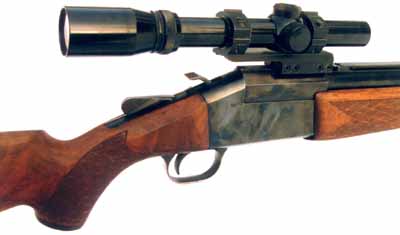
Scope mount for combo gun
Can you tell me where I can buy scope mounts for the Valmet 412S combination
rifle/shotgun?
R.P.
Photo: BR-Tuote scope
mount on Tikka rifle/shotgun. See also export contact.
From
distributor of SAKO and TIKKA firearms. Former VALMET 412S is today made in Italy for SAKO
Oy as TIKKA 512S. Quickly-detachable mounts SAKO OPTILOCK are fit for VALMET 412S, TIKKA
412S/ 512S guns and discontinued PETRA/ HUNTER selfloader rifle. There is a choice of
Optilock mounts as follows:
Scope dia. Height Outside
dia. of objective.
25.4 mm/ 1" Low
30.5 mm 55 mm
ditto
Medium 35.5 mm 65 mm
ditto
High 40.5
mm 75 mm
30 mm
Low 32.5 mm
59 mm
ditto
Medium 36.5 mm 67 mm
ditto
High 40.5
mm 75 mm
Note: Listed outside diameters of objective are maximum readings! See also selection of
mounts from BR-TUOTE website.
1803 MMI; PT
Subsonics for G3
Hello, I was reading an article by you at the "Gunwriters on the Web" on subsonic ammunition. I am interested in making a subsonic load
with a 150 grs bullet for my service G3 rifle. Do you have any suggestions (safe ones) as
to how I should start and what powders and primers to use, and could you tell me if it
will be possible for the rifle to autoload a new cartridge with subsonic charge! I would
appreciate the answer very much!
Sincerely Lars from Norway
If you
can remove the locking rollers from your G3, using it as a "straight" blowback
rifle without element of delayed blowback, there is at least theoretically possible to get
autoloading function with subsonic loads. I think, however, that it is better to be safe
than sorry and load the rifle manually for each shot. (Above mentioned trick is NOT tried,
as well as I know! Without possibility to get a G3 for research I am unable to calculate
proper loads for non-delayed action of this very rifle).
Our "policy" for loading of ss-loads is to use as easy-to-ignite powder as is
available. Most widely used is VihtaVuori N310, but our test-shooter Markus (MPP) has also
HODGDON "CLAYS" (original Australian) powder for loading trials in next summer.
Swedish NORMA R1 is tested and found to be excellent stuff for .308 Win. subsonics, but it
is expensive even in Sweden: Price per kilogram of R1 is about twinfold when compared with
N310. Loading data is same for N310 and R1. VihtaVuori's N320 is also OK for ss-loads.
Primers used are CCI-200 Large Rifle Primers. Safe powder charge for first shooting trials
is 0.50 gram of N310, N320 or R1. (Accidental double charge shall generate a chamber
pressure about as high as a factory-load, but not yet dangerous overpressure in .308
Winchester cartridge with 150 grs bullet).
If the bullet velocity is transsonic or supersonic, you should reduce the charge
(carefully) until the "cracky" flight noise of bullet is absent. PLEASE NOTE:
Before test-shooting with ss-loads you should remove ALL jacket metal fouling from the
bore of your rifle. Otherwise, velocity difference of first and the next shots may be
considerable, as much as 10 % from average muzzle velocity.
1803 MMI; PT.
Unknown author(ity)
I just visited the "Gunwriters on the Web" site and I was quite impressed by the
loads of info to find in there. I really liked it, but I guess that some simple search
engine would make it much easier and pleasant to use. However, I have a certain question,
which I propose is not listed in the Q&A section of the site... ;-)
I'm interested in a German gunwriter, name Siegfried F. Huebner, whom I saw
mentioned in an article at your site. I would very much like to find more about him, as
well as about his books (of which I've only read 2 and heard about other two). Some kind
of listing of his titles would be just wonderful to me... Would you, please, give me a tip
on where to seek on the WWW or in your site particularly? Hope, that's not too much
trouble... I'll be very thankful for your help!
Regards: Zanko
Our
activities are divided so that I'm producing the text only, without - practically speaking
- any knowledge about computer technology and layout of sites. Some outsiders have
presumably tried to organize the sites (we publish two of them, another in Finnish), but mission seems to be impossible due to the huge
quantity of scattered material. I have not time and competence for this toil. Our
"telegraph operator"/ layout maker lacks also time for any more extra bustle.
So: Let's suffer..!
I have no knowledge about SIEGFRIED F. HÜBNER, but just one of the books written by
S.F.H. I don't know, whether he is/was citizen of Germany or Switzerland. (At least two
suppressors of his design were patented in Switzerland). That book I possess:
"SILENCERS FOR HAND FIREARMS" is published in USA by PALADIN
PRESS in 1976. I have, however, seen the same book with German text in earlier 1970s.
Code number of edition in Enlish is ISBN 0-87364-055-1. I presume that this book has been
out of print years ago: No idea about reprints. Unfortunately I have not E-mail address of
Paladin Press at hand. Folks of Paladin may have some information about S.F.Hübner
(Huebner), I think so.
0903 MMI; PT
Drawings of ORIGINAL BRENNEKE SLUG
Dear Sir, I'm trying to find in Internet drawings of Brenneke slug with all
dimensions (12 g). Unfortunately I can't find anything. Could you help me, please. Thanks
in advance.
Sincerely, Ivan, Ukraina
Sorry; I
have not dimensional drawings of BRENNEKE SLUG easily available, or available at all. Also
I have not these slugs or shotshells loaded with them in my possession. Try to find E-mail
address of cartridge manufacture RWS (Germany) and ask whether peoples of RWS are willing
to help you. They are makers of ORIGINAL BRENNEKE slugs and shotshells loaded with them.
1903 MMI; PT
GOW/ Bilinguals:
From Gun Control to genocides
Tervehdys PT, Selailin netistä erilaisilla hakusanoilla kaikenkarvaista aseasiaa ja
törmäsin melko mielenkiintoiseen artikkeliin. Linkki on http://thecowboysplace.com/gun_news.htm
. Jos tästä artikkelista on jotain hyötyä aseitten kieltämissuunnitelmien
tukahduttamiselle, niin toivon että tätä käytettäisiin hyväksi. Näin voin ehkä
itsekin olla vaikuttamassa omalta osaltani edes vähän siihen ettei tulevaisuudessa
kymmenkunta tussariani joudu sulattoon....
Terveisin; ML.
Are you considering backing gun control laws??? Do you think that because you may not own
a gun, the rights guaranteed by the Second Amendment don't matter?
CONSIDER THIS...
In 1929 the Soviet Union established gun control. From 1929 to 1953, approximately 20
million dissidents, unable to defend themselves, were rounded up and exterminated. In
1911, Turkey established gun control. From 1915-1917, 1.5 million Armenians, unable to
defend themselves, were rounded up and exterminated.
Germany established gun control in 1938 and from 1939 to 1945, 13 million Jews, gypsies,
homosexuals, the mentally ill, and others, who were unable to defend themselves, were
rounded up and exterminated.
China established gun control in 1935. From 1948 to 1952, 20 million political dissidents,
unable to defend themselves, were rounded up and exterminated.
Guatemala established gun control in 1964. From 1964 to 1981, 100,000 Mayan Indians,
unable to defend themselves, were rounded up and exterminated.
Uganda established gun control in 1970. From 1971 to 1979, 300,000 Christians, unable to
defend themselves, were rounded up and exterminated.
Cambodia established gun control in 1956. From 1975 to 1977, one million
"educated" people, unable to defend themselves, were rounded up and
exterminated.
That places total victims who lost their lives because of gun control at approximately 56
million in the last century.
Since we should learn from the mistakes of history, the next time someone talks in favor
of gun control, find out which group of citizens they wish to have exterminated.
It has now been 12 months since gun owners in Australia were forced to surrender 640,381
personal firearms to be destroyed, a program costing the government more than 500 million
dollars. The results Australia-wide; Homicides are up 3.2%, Assaults are up 8 %, and Armed
robberies are up 44% In that country's state of Victoria, homicides with firearms are up
300%.
Over the previous 25 years, figures show a steady decrease in armed robberies and
Australian politicians are on the spot and at a loss to explain how no improvement in
"safety" has been observed after such monumental effort and expense was
successfully expended in "ridding society of guns." It's time to state it
plainly: Guns in the hands of honest citizens save lives and property and, yes,
gun-control laws only affect the law-abiding citizens. Take action before it's too late:
Write or call your delegation.
Paul H:y. Edited by: PT
ADVERTISEMENT:
KNOWLEDGE ON NAGANT REVOLVERS IS AVAILABLE!
(TIETOPAKETTI NAGANT-REVOLVEREISTA NETISSÄ)
Our new E-book : "THE NAGANT REVOLVERS" is now available on our site: http://users.skynet.be/HL-Editions/index.html
. Since the collapse of the Berlin-wall, many kinds of firearms which were rarely
available before, are now pouring towards the West from former Soviet countries. Among
those is a very interesting revolver that has a "gas seal" system which was
designed by the Belgian firm Nagant, and dates back to 1895. The historic details of this
unique handgun are not very well known even though it was produced in vast quantities -
some 2,000,000 pieces - by Russia and Poland until the end of WW II.
The Nagant firm was in it's day one of the most renowned firms in the European light
firearm's business. The success of it's "gas seal" revolver model 1895 is
undoubtedly due to its official adoption by the Imperial and later Soviet Russia. But the
firm Nagant did not enter the business in 1895. Before the model 1895 was issued, there
was a whole family of revolvers starting with the model 1878, adopted by Belgium, and
ending in 1910 with a quite rare "gas seal" model fitted with a side-swinging
cylinder.
With this E-book, you will be able to follow step by step, revolver by revolver, the
unwinding of the historical facts relating to the firm Nagant with a particular focus on
the mechanical principles that were put together to obtain a unique handgun which many
people have now the chance to own at a very low price.
E-book content:
The Nagant firm history: From firearms to automobiles.
The Nagant revolver Model 1895 - historical recall
- The first developments.
- The Nagant and Pieper's cartridge.
- Russia under the reign of Alexander III.
- Licence of production to Russia.
- Markings on the model 1895.
- Shift from single to double-action mode.
- Variations of the model 1895.
- Takedown of the Nagant Mod. 1895
- Takedown procedure with pictures.
- Trick to ease the hammer takedown alone.
- Mechanical principles of the revolver Nagant Mod. 1895
- The answer to gas leakage at the barrel-cylinder joint.
- The 7,62 mm Nagant ammunition.
- Lock of the revolver Nagant Mod. 1895
- The revolver Nagant model 1895 owns a true breech lock.
- Animated sequence on the locking process.
- Shooting in single and double action.
- Rebounding hammer.
- Animated sequence about the double-action mode
- The performance of the revolver Nagant Mod. 1895
- One can first criticize the tremendous trigger's weight.
- A Russian trick to greatly diminish the trigger's weight.
- An obsolete loading system.
- The Nagant 7.62 mm cartridge comparatively to the others.
- How to use of the .32-20 Winchester case for reloading.
The Nagant revolvers of the Belgian Army
- Specific markings.
- The model 1878 in caliber 9,4 mm.
- The 9,4 mm Nagant cartridge.
- The model 1883 in single action.
- The model 1878/86 in double action with a simplified lock.
- The model 1883 in double action.
- Belgian Army revolvers holsters
- Five models presented.
The Nagant revolvers of the Grand-duché of Luxembourg
- First model termed "Officers Mod. 1884".
- Second model termed "Mod. 1884 for officers with safety".
- Third model or Mod. 1884 for gendarme.
- The removable bayonet.
- Table of the different models compared.
The Swedish Nagant revolvers
- The Swedish model 1887 in caliber 7,5 mm.
- The Husqvarna production.
The Serbian Nagant revolvers
- The Serbian Nagant Mod. 1891
- Technical characteristics of the Serbian model.
- Specific markings
The Nagant revolvers of South America
- The South American Nagant in cal. 11 mm.
- The .44 Nagant Brazilian (11,2 x 20R) and .440 Nagant Argentinian (11,2 x 22R).
- The South American Nagant revolvers compared to the Belgian 1878 to 1886 models.
- Table of comparison.
The Nagant revolver Mod. 1910
- When León Nagant passed away.
- The Nagant brothers decided to improve the model 1895.
- Characteristics of the model 1910
Nagant's patents about firearms
- Patents list
- The current value of the Nagant revolvers (B & B sales)
- Bibliography
More Q&A >>
<< New Q&A More Q&A, Part 11 >> Part 10
>> Part 9 >> Part
8 >> Part 7 >> Part 6 >> Part 5 >>
Part 4 >> Part 2 >>
Part 1 >> Gunwriters
guns.connect.fi Link page